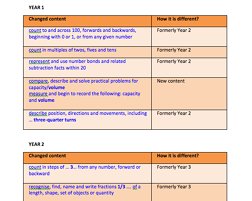Most teachers are beginning find their way through the new National Curriculum in readiness for September. Here is a file to download with the details of the changes between the current and new KS1 and KS2 maths Programmes of Study.
Most teachers know that understanding the mathematics behind any method is important for children to gain real confidence and a ‘feel’ for maths.
We could quote Richard Skemp and discuss relational and instrumental understanding, explaining the problems inherent in rote learning. However, it is likely you will just smile and say how interesting it is – and actually, these ‘tricks’, are sometimes quite interesting.
I was challenged to multiply 48394 by 11 in less than 10 seconds.
The method I was shown was this:
The last digit is the last digit of the answer, then add the last digit to the previous digit, repeat and carry the ten if needed.
It works – and it would be a good investigation to see why it works.
However there is no obvious relationship between the method and the value of the numbers. It is an interesting ‘trick’ – even if based on long multiplication and adding adjacent digits.
In a few months, if I want to multiply by 11 again, I have to remember this method or ‘trick’. As there is no understanding of why it works, I would struggle to remember it.
The method I was shown was this:
The last digit is the last digit of the answer, then add the last digit to the previous digit, repeat and carry the ten if needed.
It works – and it would be a good investigation to see why it works.
However there is no obvious relationship between the method and the value of the numbers. It is an interesting ‘trick’ – even if based on long multiplication and adding adjacent digits.
In a few months, if I want to multiply by 11 again, I have to remember this method or ‘trick’. As there is no understanding of why it works, I would struggle to remember it.
7 8 5 9 4 → → _ _ _ _ _ 4
7 8 5 9 4 → 9+4 = 13 → _ _ _ _ 3 4
7 8 5 9 4 → 5+9 (+1 carried over) = 15 → _ _ _ 5 3 4
7 8 5 9 4 → 8+5 (+1 carried over) = 14 → _ _ 4 5 3 4
7 8 3 9 4 → 7+8 (+1 carried over) = 16 → _ 6 4 5 3 4
7 8 3 9 4 → 7 (+1 carried over) → 8 6 4 5 3 4
(This can be done quickly with a simple short method with pen and paper)
Interestingly I can complete the multiplication in less than 10 seconds using a method that most KS2 children could use - and remember.
Multiply by 10, then multiply by 1 and add together.
7 8 5 9 4 x 10 → 7 8 5 9 4 0
7 8 5 9 4 x 1 → + 7 8 5 9 4
8 6 4 5 3 4
If children understand what they are doing they don’t need to remember a rule, they can work out the right method – and do it faster!
Using these two methods illustrates an important thing - don't confuse a written algorithm with rote learning. I used a written algorithm to answer the calculation, but I did it with understanding, not as a rote learnt procedure like the trick above.
Multiply by 10, then multiply by 1 and add together.
7 8 5 9 4 x 10 → 7 8 5 9 4 0
7 8 5 9 4 x 1 → + 7 8 5 9 4
8 6 4 5 3 4
If children understand what they are doing they don’t need to remember a rule, they can work out the right method – and do it faster!
Using these two methods illustrates an important thing - don't confuse a written algorithm with rote learning. I used a written algorithm to answer the calculation, but I did it with understanding, not as a rote learnt procedure like the trick above.



